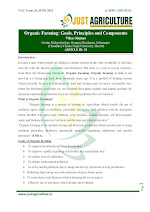Glycolysis
Glycolysis (Gk. glykys = sweet, lysis = splitting),
also called glycolytic pathway or Embden-Meyerhof-Parnas (EMP) pathway,
is the sequence of reactions that metabolises one molecule of glucose to two
molecules of pyruvate with the concomitant net production of two molecules of
ATP.
Glycolysis is almost an universal central pathway of
glucose catabolism, and the complete pathway of glycolysis was elucidated by
1940, largely through the pioneering contributions of G. Embden, O. Meyerhof,
J. Parnas, C. Neuberg, O. Warburg, G. Cori, and C. Cori.
However, glycolysis occurs in all major groups of
microorganisms and functions in the presence or absence of oxygen. It is
located in the cytoplasmic matrix of the cells of an organism. The whole
process of glycolysis (i.e., the breakdown of the 6-carbon glucose molecule
into two molecules of the 3-carbon pyruvate) occurs in ten steps.
The first five-steps constitute the preparatory phase while
the rest live-steps represent the payoff phase (oxidation phase). In
preparatory phase there is phosphorylation of glucose and its conversion to
glyceraldehyde 3-phosphate at the expense of two molecules of ATP.
Oxidative conversion of glyceraldehyde 3-phosphate to
pyruvate and the coupled formation of ATP and NADH is the feature of payoff
phase.
The main thing in the steps of Glycolysis is to remember
the envolved enzyme, pre-existing substrate and the product. The step-wise
concise account of glycolysis is the following:
1. Glucose (hexose sugar) is activated for
subsequent reactions by its phosphorylation to yield glucose 6-phosphate,
with ATP as the phosphoryl donor. This reaction, which is irreversible under
intracellular conditions, is catalyzed by enzyme hexokinase, which
requires Mg2+ for its activity.
2. Enzyme phosphohexose isomerase (phosphoglucose
isomerase) catalyzes the reversible isomerization of glucose 6-phosphate
(an aldose) to fructose 6- phosphate (a ketose). Phosphohexose isomerase
requires Mg2+ and is specific for glucose 6-phosphate and fructose 6-phosphate.
3. Enzyme phosphofructokinase catalyses the transfer
of a phosphoryl group from ATP to fructose 6-phosphate to yield fructose
1, 6-bisphosphate. This reaction is essentially irreversible under cellular
conditions. Phosphofructokinase also requires Mg2+ for its activity.
4. The enzyme fructose 1, 6-bisphosphate aldolase,
often called simply aldolase catalyses the cleavage of fructose
1,6-bisphosphate to yield two different triose sugar phosphates, glyceraldehyde
3-phosphate (an aldose) and dihydroxyacetone phosphate (a ketose).
5. Glyceraldehyde 3-phosphate (G3P) and dihydroxyacetone
(DHAP) phosphate are inter-convertible. Only glyceraldehyde 3-phosphate
is directly degraded in the subsequent steps and, therefore, dihydorxyacetone
phosphate is rapidly and reversibly converted to glyceraldehyde 3- phosphate by
the enzyme triose phosphate isomerase. This reaction completes the
preparatory phase of glycolysis.
6. This step is the first step of payoff phase of
glycolysis, Glyceraldehyde 3-phosphate oxidises to 1, 3-
bisphosphoglycerate with the involvement of enzyme glyceraldehyde 3-
phosphate dehydrogenase. During this reaction NAD+ is reduced yielding NADH
(oxidative phosphorylation).
7. 1, 3-bisphosphoglycerate is converted to 3-phosphoglycerate.
In this reaction the enzyme phosphoglycerokinase transfers the
high-energy phosphoryl group from 1,3- bisphosphoglycerate to ADP yielding ATP
and 3-phosphoglycerate. The formation of ATP by phosphoryl group
transfer from a substrate (1,3-bisphosphoglycerate) is called substrate level
phosphorylation.
8. 3-phosphoglycerate is now converted to 2-phosphoglycerate.
In this reaction the enzyme phosphoglycerate mutase catalyses a
reversible shift of the phosphoryl group between C-2 and C-3 of glycerate; Mg2+
is essential for this reaction.
9. In this step the enzyme enolase promotes reversible
removal of a molecule of water from 2-phosphoglycerate to yield phosphoenolpyruvate.
10. This is the last step in glycolysis. Phosphoryl group
from phosphoenolpyruvate is transferred to ADP by enzyme pyruvate kinase
to yield ATP and pyruvate via substrate level phosphorylation.
The enzyme pyruvate kinase requires K and cither Mg2+ or Mn2+ for its activity.
The whole of glycolysis can be represented by the following
simple equation:
Glucose + 2ADP + 2Pi+ 2NAD+ = 2
pyruvate + 2ATP + 2NADH + 2H+
Thank You
Vikas Kashyap :)











0 Comments